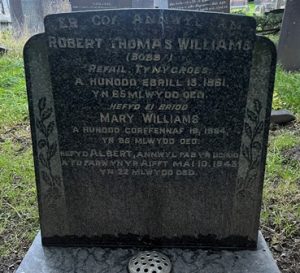Caerhun is a rural community, and parish, on the west bank of the river Conwy which lies to the south of Henryd and the north of Dolgarrog, in the ancient county of Caernarfonshire. The community incorporates the villages and hamlets of Llanbedr-y-Cennin, Rowen, Tal-y-Bont and Tyn-y-Groes. The ancient parish church is dedicated to St. Mary and lies within the borders of the Roman fort of Canovium. The fort was built to safeguard one of the crossings over the river Conwy. Situated inside the Church is the original etched brass war memorial to the members of the parish who served and fell during the Great War of 1914-1918. There is also another, more modern, brass memorial plaque to all of the parishioners who fell during both World Wars, and these men are also commemorated on the Caerhun Parish War Memorial, which is situated adjacent to the Red Lion, at Tyn-y-Groes.
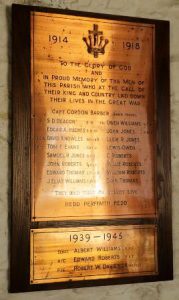
The Great War, 1914-1918
Gordon Barber, Captain, Cameron Highlanders. Gordon was born on 26 December 1892, the son of John Barber and Jane Barber (nee Muir), of Little Heys, Bromborough, Cheshire. He was educated at Dunchurch and Bradfield College, and after leaving college worked as a clerk for his father at Messrs. Harrison Bros., corn merchants. Gordon was a member of the Birkenhead Football Club, and vice president of the New Brighton Cricket Club, and had a residence at Ty’nyfedw, Caerhun. Gordon had enlisted into the Territorial Army as a young man, joining the 10th Battalion, The King’s (Liverpool Regiment) and had been commissioned as Second Lieutenant into the 3rd Battalion, The Queen’s Own Cameron Highlanders on 5 February 1913. The battalion was the regiments reserve battalion, and Gordon was on the Reserve of Officers list. He was mobilised at the outbreak of war and posted to the 1st Battalion, The Queen’s Own Cameron Highlanders. The battalion was in Edinburgh when war was declared and landed at Le Havre on 14 August 1914, initially as Army troops. On 5 September the battalion joined 1 Brigade, 1st Division, which had suffered heavy losses during the Battle of Mons and the subsequent retreat to the Marne. Gordon embarked for France on 22 September, joining the battalion on the Aisne, following heavy losses at Vendresse from 14 September. The Germans had by now entrenched in positions along the Chemin des Dames Ridge, and the French took over the sector, allowing the BEF to begin moving to Flanders from 14 October. The 1st Division then saw heavy fighting during the First Battle of Ypres, helping to prevent the city falling into German hands over the coming weeks. The 1st Division then moved to the Neuve Chapelle area where it wintered and saw its first major action of 1915 here on 9 May 1915, during the Battle of Aubers Ridge, when it attacked alongside the Meerut Division. In May the division moved to the Cuinchy area, where it endured a great deal of bombing and rifle grenading, then at the latter end of June moved to the Vermelles area, in preparation for the battle of Loos. The Battle of Loos was launched on 25 September 1915, following the release of large quantities of poison gas by the British, and the 1st Division saw heavy casualties as it took part in the opening assault. After further fighting around the Hohenzollern redoubt, the division wintered in the Loos sector. During July 1916 the Division moved south, to join the great Somme offensive, reaching Albert by 11 July and moved into positions facing Bazentin Ridge. The 1st Cameron Highlanders moved into the front line at Bazentin-le-Petit Wood on 21 July, relieving the 1st Black Watch. Gordon was killed in action here on the following day, 22 July 1916, during an assault upon the German line between the Bazentin to Martinpuich road. The 24-year-old was buried in Becourt Military Cemetery, Becordel-Becourt, France.
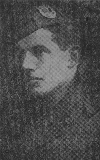
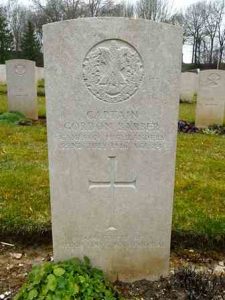
Stanley Douglas Deacon, Gunner, RMA/9576, Royal Marine Artillery. Stanley was born at Heaton Norris, Manchester on 2 August 1882, the son of Stanley Wagstaffe Deacon and Rose Emma Deacon (nee Gardner). By 1901 the family was residing at 45, Rufford Road, Southport. Stanley enlisted into the Royal Marine Artillery on 29 May 1901 and after completing his training spent the coming years serving aboard a number of ships, including HMS Bacchante; HMS Crescent; HMS Powerful; and HMS Terrible. He left the Royal Marines on 28 May 1910, and became a Reservist, returning home to his parents, who by then had moved to 9, Union Street, Stretford, Lancashire. Stanley had then moved to Caerhun. He was mobilised at the outbreak of war and was posted as a Gunner aboard the Drake-class armoured cruiser, HMS Good Hope. Good Hope was swiftly recommissioned from the reserve fleet after Stanley joined its crew, before she joined the 4th Cruiser Squadron, under the command of Rear Admiral Christopher Cradock. Good Hope then steamed across the Atlantic together with HMS Suffolk to Halifax, Nova Scotia. The squadron was then despatched to South America to hunt for German intruders preying on British Merchant ships, stopping off in the West Indies to take aboard more crew on their way. The squadron then moved further south in late September to search for the German East Asia Squadron, under the command of Vice Admiral Graf Maximilian von Spee, which was known to be in the vicinity of Cape Horn and the Strait of Magellan. The first searched proved futile, so on 15 October Good Hope returned to Port Stanley to recoal, whilst three other ships sailed to Valparaiso. The ageing pre-dreadnaught, HMS Canopus then joined the squadron, so Good Hope steamed out of Stanley on 22 October, rounding Cape Horn and joining back with the rest of the ships off Chile on 27 October. German radio signals were then picked up, so the squadron set off to intercept the Germans off Coronel. Both fleets came into contact on 1 November 1914 and began firing, however Cradock’s force found it was outgunned by the German’s superior 21cm guns, so were forced to close in. The battle raged, but as darkness fell, the British found themselves silhouetted by the setting sun and became easy targets. Good Hope suffered at least 35 hits from the German large calibre guns, before sinking with the loss if all hands, some 926 officers and men. HMS Monmouth had also been sunk, resulting in the battle being the first loss by a Royal Navy force since 1812. Stanley was 32 years old when he was lost during the sinking of Good Hope that day. He has no known grave but the sea, so is commemorated on the Portsmouth Naval Memorial, Hampshire.
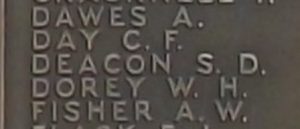
Thomas Foulkes Evans, Private, 41358, Suffolk Regiment. Thomas was born in 1885, the son of Robert Foulkes Evans and Margaret Ann Evans (nee Owens), of Porthllwyd, Caerhun. His father had been the Deacon of the Calvinistic Methodist Church at Talybont and the manager of a slate quarry at Talysarn for several years, until he sadly died in 1894. Margaret then moved with her children to Cennin House, Llangystennin, before buying her own boarding house, Cherville, at Meirion Gardens, Colwyn Bay. Thomas worked as a furnaceman in an aluminium works prior to the war. He enlisted into the Training Reserve at Woolwich in 1916 and was initially posted to the Bedfordshire Regiment. Upon being drafted to France in the spring of 1917, Thomas was posted to the 4th Battalion, Suffolk Regiment, which was by then attached to 98 Brigade, 33rd Division. The division had fought during the Battle of Bullecourt, spending the early summer of 1917 on the Hindenburg Line, near Boyelles, then in July was relieved and marched to Warlus, where several weeks of training commenced. At the end of the month the division entrained for the Belgian coast, detraining at Adinkerke before marching to La Panne and took up positions in the front line near the coast. At the beginning of September, the division was withdrawn and began to move into the Ypres Salient, to bolster the Allied offensive on Passchendaele Ridge. On 24 September the division moved into reserve at Clapham Junction, east of Ypres, and on the following day moved into the front line, to prepare for an assault. After a slight delay, on 26 September 1917 the division launched an assault north of Polygon Wood. Thomas was killed in action during the fighting that day, during a successful assault. The 31-year-old was buried in St. Julien Dressing Station Cemetery, Belgium.
John Edward Griffiths, Private, 73136, Royal Welsh Fusiliers. John was born in 1886, the son of John Griffiths and Jane Griffiths, of Dyserth, Flintshire. By 1911 he was lodging at 9 Castle Street Conway, where he worked as a Grocer’s Assistant. John married Elizabeth Jane Jones in the autumn of 1914 and the couple had a daughter, Diulys, born on 4 December. John enlisted at Bangor into the Royal Welsh Fusiliers, and trained at Kinmel Park before being drafted out to Egypt. He was then posted to the 1/7th Battalion, Royal Welsh Fusiliers, which was attached to 158 Brigade, 53rd (Welsh) Division. The Division had been evacuated from Gallipoli in December 1915, moving to Egypt to join the EEF, and helped guard the Suez Canal before taking part in operations to drive the Turks out of the Sinai. The EEF then turned its attention onto driving the Turks out of Palestine, and on 26 March 1917 launched its first offensive against the coastal city of Gaza, which guarded the road to Jerusalem. Initial gains during the day were lost when the assaulting divisions lost touch with each other and communication broke down when a thick fog cloaked the battlefield. A second attempt to force Gaza was launched on 17 April, which also failed, and the EEF suffered a change in leadership, with Sir Edmund Allenby assuming command, before being re-organised, and a third offensive was launched against a wider front from Beersheba to Gaza on 31 October 1917. This time the Turkish defences were breached, and the road to Jerusalem now lay open and the EEF began to advance north. On 6 November 1917, 158 Brigade launched an attack on the Khuweilfeh Heights. John was killed in action during the attack that day. The 31-year-old is buried in Beersheba War Cemetery, Israel. John is not commemorated on the Caerhun war memorial, although his daughter later became headmistress at Caerhun School, and his widow lived at the School House with her for many years, until her death in 1958. His wife and daughter are both buried in St. Mary’s Churchyard, Caerhun.
David Arthur Hughes, Gunner, 190416, Royal Field Artillery. David was born at Llanerfyl in 1880, the eldest son of David Arthur Hughes, a school master from Llandovery, and Anne Hughes (nee James). His mother died in 1905, by which time the family had moved to the School House, at Tal-y-Cafn. David married Elizabeth Emily Jones in 1909 and the couple settled at Bristol House, Trecastle, Breconshire, where David worked as a bootmaker and ran his own grocer’s business. He enlisted into the Royal Field Artillery at Brecon some time after the outbreak of war and was posted to the Depot at Preston for training. David suffered a heart attack and died in the Public Hall at Preston on 31 January 1917. The remains of the 36-year-old were brought home and he was buried with full military honours in St. Mary’s Churchyard, Traianglas, Breconshire. One of his brothers, Edgar Arnold Hughes, was lost at sea later that year. David is not commemorated on the Caerhun war memorial.
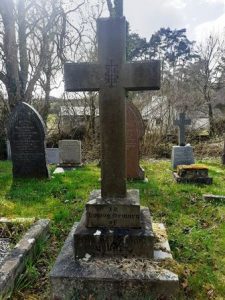
Edgar Arnold Hughes, Sailor, Mercantile Marine. Edgar was born at Penmachno in 1895, the son of David Arthur Hughes, a school master from Llandovery, and Anne Hughes (nee James). His mother died in 1905, by which time the family had moved to the School House, at Tal-y-Cafn. By 1911 Edgar was lodging at the Market House, Abergele, where he was training as a grocer. He enlisted into the Mercantile Marine soon after the outbreak of war and was posted aboard the London registered steamship, the SS Castilian. The Castilian had been built in 1890 and was formerly named the SS Umbilo. It was under that guise that in 1898 she transported Dinuzulu kaCetshwayo, King of the Zulus, to Natal after seven years exile on St Helena. Following being renamed as SS Castilian, she was later taken under control of the Admiralty and took part in the Atlantic crossings, carrying much needed material back to Britain from America. On 18 April 1917, Castilian was steaming off the north coast of Ireland when she was torpedoed and sunk by the German submarine SM U-61. Edgar was 21 years old when he died in the sinking that day. He has no known grave but the sea, so is commemorated on the Tower Hill Memorial, London. Several of his brothers also served during the war, one of whom, his eldest brother David Arthur Hughes, died of heart disease, brought about by his military service, in 1917.
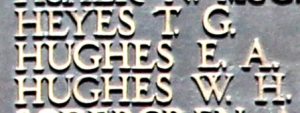
John Jones, Private, 15471, Royal Welsh Fusiliers. John was born in 1899, the son of Evan Jones and Grace Jones, of Llain, Caerhun. He enlisted at Conway into the 10th Battalion, Royal Welsh Fusiliers soon after the outbreak of war. The battalion had formed at Wrexham in September 1914, joining 76 Brigade, 25th Division at Codford St. Mary, Salisbury Plain. In November 1914 the battalion moved to billets at Bournemouth, then at the end of April 1915 moved to Romsey before moving again to Aldershot to complete its training. The battalion landed at Boulogne on 27 September 1915 and the entire division moved to the Ypres Salient for trench initiation, before taking over the line at St. Eloi, near Ypres. The Division saw heavy fighting during the Actions of the Bluff in February 1916 and then at the Actions of the St Eloi Craters from 27 March to 16 April. Arthur probably joined the 10th RWF after one of these actions, due to heavy losses suffered by the battalion. The battalion continued to suffer during these months at St. Eloi, coming under a gas attack for the first time on 29/30 April. By the middle of June, the Division had moved out of the Ypres Salient to billets around Eperlecques, where intense training was carried out prior to moving to the Somme sector by 2 July. The main Somme offensive had opened on the previous day, and the 3rd Division was ready to enter the fray, bivouacking at Bronfay Farm by 9 July and on 13 July moved into the captured German lines at Montauban Alley. The 10th RWF took part in heavy fighting over the coming days, and on 19 July received orders for an assault on Delville Wood. Just after midnight the following day the battalion moved forwards and became caught in in terrible fighting within the wood, the fighting of such severity that two men of the battalion were awarded the Victoria Cross. On 25 July the shattered battalion was relieved and moved into reserve and did not move back into the line until 17 August, when the battalion attacked Lonely Trench. John was wounded during the attack and was evacuated to the 5th Casualty Clearing Station at Corbie, where he died of his wounds on 19 August 1916. The 17-year-old was buried in Corbie Communal Cemetery Extension, France.
Llewelyn Roberts Jones, Private, 203626, Royal Welsh Fusiliers. Llewellyn was born in 1896, the son of Ann Jane Roberts, of Tan-y-Bwlch, Caerhun. His mother appears to have married Rowland Jones at some time after and the family later moved to Fron Haul, Llanbedr-y-Cennin. Llewelyn became known as Llewelyn Roberts Jones. Llewelyn enlisted into the 4th Battalion, Royal Welsh Fusiliers and was posted to Park Hall Camp, at Oswestry, for training. He had not been in camp long before he took ill, and he died there of pneumonia on 18 February 1917. The body of the 19-year-old was brought home and he was buried in St. Peter’s Churchyard, at Llanbedr-Y-Cennin. (Llewelyn’s story is rather odd, as the CWGC records state that he was the husband of Anne Jane Roberts (nee Jones), and that he served under the alias of Llewelyn Jones, when he was in fact Llewelyn Roberts, and Ann was his mother!)
Samuel Richard Jones, Rifleman, 555077, London Regiment. Samuel was born in 1898, the son of Hugh Jones and Margaret Jones (nee Evans), of The Post Office, Tal-y-Cafn. He lived at Norbury, in London, prior to the war and enlisted at Croydon into the 16th Battalion, London Regiment, known as the Queen’s Westminster Rifles. He was drafted to France on 5 October 1917 to join the battalion, but just two days later was instead posted to the 1/9th Battalion, London Regiment. The battalion was known as the Queen Victoria’s Rifles, and was a Territorial Army battalion, attached to 169 Brigade, 6th Division. Samuel joined the battalion at Louverval, where the division was holding a section of trenches facing the Hindenburg Line. On 20 November 1917 the British launched a huge offensive against the Hindenburg Line, marking the opening of the Battle of Cambrai. The 6th Division was in the centre of the attack and captured Ribécourt and Marcoing but due to the relieving cavalry being late, were repulsed from Noyelles. Heavy fighting raged for days, then on 30 November the Germans counter-attacked, retaking all of their lost ground, and forming a salient around Flesquières. The fighting then calmed down over the winter. On 1 February 1918, as part of the reorganisation of the British Army, the 1/9th London and the 2/9th London merged at La Neuville, forming the 9th London, and joined 175 Brigade, 58th (London) Division. The battalion then entrained at Corbie for Apilly and over the coming days marched to Liez Quarry to join its new division. On 21 March 1918 the Division, holding positions near St. Quentin, was hit hard following the opening stage of the German spring offensive and suffered heavily as it was driven back towards Villers-Bretonneux. German attention then turned north to the Lys valley, so the fighting here settled down, until 8 August 1918, when a combined Allied offensive broke the German lines at Villers-Bretonneux. Then on 21 August the Allies launched a general offensive along the Somme front and began driving the Germans back towards the Hindenburg Line. The 58th Division attacked along the north of the river Somme and crossed the Bapaume to Péronne road within days, then by 7 September reached Saulcourt, capturing the village of Guyencourt. Attention then turned towards Épehy, which was part of the outer defensive system to the Hindenburg Line and thus strongly defended by the Germans, and on 18 September several divisions attacked, breaking the outer defences and leaving the main Hindenburg Line as the last defensive system for the Germans. Samuel was wounded during this period and was evacuated to hospital at Rouen, where he died of his wounds on 9 October 1918. The 20-year-old was buried in St. Sever Cemetery Extension, Rouen, France.
David Knowles, Lance Corporal, 277422, Manchester Regiment. David was born in 1898, the son of William Knowles and Mary Jane Knowles (nee Evans), of Tynrhwylfa, Tynygroes, Tal-y-Cafn. He enlisted at Bangor into the Royal Welsh Fusiliers. David was then posted to the 2/7th Battalion, Manchester Regiment. The battalion had formed in Manchester in August 1914, joining 199 Brigade, 66th (East Lancs) Division. The division remained in Lancashire until about May 1915 and then moved to the Crowborough area, before moving again in March 1916 to Colchester to complete its training. In February 1917 the division landed in France, moving to the Cambrin Sector for trench initiation and training. On 16 June the division was relieved, and its units began entraining for the Dunkirk area, prior to taking up positions in the line on the Flanders coast. The move was part of the so-called Operation Hush, which involved transferring several divisions to the area in readiness for an offensive along the coast, if the Allies managed to break through during the Passchendaele offensive, which was to open on 31 July. Within weeks of this offensive opening, it soon became clear that the offensive here was failing, so several of the divisions on the Flanders coast were moved into the Ypres Salient, to bolster the assault upon the ridge. At the end of September 1917, the 66th Division moved to Ypres, and took part in the Battle of Poelcapelle. In the middle of October, the division was relieved and entrained at Brandhoek for Arques, to rest and refit following its efforts at Ypres. Returning to Ypres for the winter, the division was then transferred south at the beginning of February 1918 and moved to Harbonnières, on the Amiens to St. Quentin Road, before taking over the Villeret Sector. At dawn on 21 March 1918 the Germans opened up a terrible artillery barrage along the front, before launching an infantry assault along the section of line running south from Croisilles to La Fère. The division was hit hard, suffering terrible casualties over the coming days, with the 2/7th Manchester’s alone losing over 500 men. David was posted as missing, believed killed in action during the first day of the offensive, on 21 March 1918. No trace of the 20-year-old was ever found, so he is commemorated on the Pozieres Memorial, France.
Lewis Owen, Private, 203798, Royal Welsh Fusiliers. Lewis was born in 1896, the son of William Owen and Elizabeth Owen, of Llican Ucha, Tal-y-Cafn. He worked as a cowman and labourer prior to enlisting at Conway into the Royal Welsh Fusiliers on 11 December 1915 and was initially placed on the Army Reserve. Lewis was mobilised on 8 February 1917, joining the regiment at Wrexham. He was drafted to France on 21 July 1917 and was posted to the 5th Infantry Base Depot, then on 5 August he was posted to the 15th Battalion, Royal Welsh Fusiliers, which was at Ypres, attached to 113 Brigade, 38th (Welsh) Division. The division had just taken part in its gallant assault on the Pilckem Ridge when Lewis arrived and the 15th RWF was in camp at Proven, resting and refitting. The division then played a supporting role in the Battle of Langemarck, before being transferred to the Sailly-sur-la-Lys sector in September and remained in the area over the winter. The 15th RWF was disbanded on 6 February 1918, so Lewis was posted to the 13th RWF, in the same brigade. The division was transferred south, moving to positions north of Albert, at Bouzincourt Ridge, at the end of March 1918, relieving the battered 2nd and 47th Divisions. It held this sector, again carrying out minor operations and trench raids, over the coming months. In April Lewis was hospitalised for two weeks as a result of boils to his body, but soon returned to action. On 21 August 1918 the Division launched an assault across the river Ancre, as part of the greater Allied offensive, and over the coming days captured Thiepval Ridge, Pozieres, Mametz Wood and High Wood, whilst advancing across the old Somme battlefields of 1916. The advance saw the Division take part in several costly assaults over the coming weeks, famously crossing the Canal du Nord, before beginning its attacks against the outer Hindenburg Line defensive system. On 16 September 113 Brigade relieved 115 Brigade in the front line facing Gouzeaucourt and on 18 September the 14th and 16th RWF launched an attack against the village, the 13th RWF remaining in reserve. At 20.00 that night the 13th RWF relieved the 16th RWF in the front line and at dawn on the following day, 19 September 1918, began attacking along African Trench. Lewis was killed in action during the fighting that day. The 22-year-old was buried in Gouzeaucourt New British Cemetery, France.
C. Roberts, Private, Royal Welsh Fusiliers. This man cannot presently be identified.
John Roberts, Private, 7017, Somerset Light Infantry. John was the son of William Roberts and Mary Roberts, of Caerhun. He left home as a young man to enlist into the Somerset Light Infantry, whilst his parents left Caerhun to live at 7, Manchester Cottages, Towyn. John embarked for France on 11 September 1914 to join the 1st Battalion, Somerset Light Infantry. The battalion was attached to 11 Brigade, 4th Division and by the time John joined its ranks, was on the Aisne, having taken part in the Battle of Le Cateau and the retreat to the Marne, where the German drive on Paris was stopped, and had helped drive the enemy back from the river Marne to the Aisne, where they had taken up positions along the Chemin-des-Dames ridge. On the night of 13 September, most of the BEF crossed the river Aisne and began to attack the German positions, but without heavy artillery support failed to gain a foothold on the ridge. The BEF was relieved by the French and began moving north to Flanders on 10 October. The 5th Division entrained on 11 October and arrived at St. Omer via Boulogne and Calais that evening before moving over the coming days towards Bailleul, crossing the river Lys at Erquinghem on the 15th. Three days later the division was ordered to move to the Nieppe area before taking over positions near Ploegsteert on the 20th. On the following day, 21 October 1914 the division came into contact with the Germans, who were attacking from positions east of Ploegsteert Wood. John was killed in action during the fighting that day. He has no known grave and is commemorated on the Ploegsteert Memorial, Belgium.
William Roberts, Private, 20914, Royal Welsh Fusiliers. William was the son of William Jones, of Caerhun. He enlisted into the 10th Battalion, Royal Welsh Fusiliers at Conway soon after the outbreak of war. The battalion had formed at Wrexham in September 1914, joining 76 Brigade, 25th Division at Codford St. Mary, Salisbury Plain. In November 1914 the battalion moved to billets at Bournemouth, then at the end of April 1915 moved to Romsey before moving again to Aldershot to complete its training. The battalion landed at Boulogne on 27 September 1915 and the entire division moved to the Ypres Salient for trench initiation, before taking over the line at St. Eloi, near Ypres. On 15 October, 76 Brigade transferred to the 3rd Division. The Division saw heavy fighting during the Actions of the Bluff in February 1916 and then at the Actions of the St Eloi Craters from 27 March to 16 April. The battalion continued to suffer during these months at St. Eloi, coming under a gas attack for the first time on 29/30 April. By the middle of June, the Division had moved out of the Ypres Salient to billets around Eperlecques, where intense training was carried out prior to moving to the Somme sector by 2 July. The main Somme offensive had opened on the previous day, and the 3rd Division was ready to enter the fray, bivouacking at Bronfay Farm by 9 July and on 13 July moved into the captured German lines at Montauban Alley. The 10th RWF took part in heavy fighting over the coming days, and on 19 July received orders for an assault on Delville Wood. Just after midnight the following day the battalion moved forwards and became caught in in terrible fighting within the wood, the fighting of such severity that two men of the battalion were awarded the Victoria Cross. On 25 July the shattered battalion was relieved and moved into reserve and did not move back into the line until 17 August, when the battalion attacked Lonely Trench. On 23 August the Division moved out of the line to rest and moved to Noeux-les-Mines, near Loos. After a month there, the Division moved back into a rest area for further training before moving back south to the Somme and by 12 November took over trenches at Serre. On the following day, 13 November 1916, the Division launched an assault against the German positions at Serre. The 10th RWF reached Serre village, but the flanking battalions failed to keep up, and heavy losses were suffered, with almost 300 officers and men killed, wounded, or missing. The division wintered on the Somme, in the Serre trenches, in terrible conditions, and at the beginning of January 1917 was relieved before moving to the Arras sector. On 9 April 1917 the Battle of Arras opened. The 3rd Division took part in the opening assault, fighting at the First and Second Battles of the Scarpe, and at the Battle of Arleux and the Third Battle of the Scarpe, where the division captured Roeux. William was killed in action while the 10th RWF were holding the line near Monchy on 16 June 1917 and came under heavy artillery fire. He has no known grave and is commemorated on the Arras Memorial, France. (The surviving records show his father as William Jones, but sadly there is no other surviving service or pension paper to provide an age or address for him).
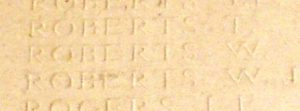
Willie Roberts, Private, 61283, Royal Welsh Fusiliers. Willie was born in 1890, the son of William Roberts and Laura Roberts (nee Williams), of Ty Gwyn, Talybont, Tal-y-Cafn. He enlisted into the Royal Welsh Fusiliers in 1917 and after being drafted to France later that summer was posted to the 15th Battalion, Royal Welsh Fusiliers, which was attached to 113 Brigade, 38th (Welsh) Division. The division had just taken part in its gallant assault on the Pilckem Ridge when Willie arrived and the 15th RWF was in camp at Proven, resting and refitting. The division then played a supporting role in the Battle of Langemarck, before being transferred to the Sailly-sur-la-Lys sector in September and remained in the area over the winter. The 15th RWF was disbanded on 6 February 1918, so Willie was posted to the 13th RWF, in the same brigade. The division was transferred south, moving to positions north of Albert, at Bouzincourt Ridge, at the end of March 1918, relieving the battered 2nd and 47th Divisions. It held this sector, again carrying out minor operations and trench raids, over the coming months. On 5 May 1918 the 13th RWF relieved the 16th RWF in the front line at Bouzincourt, to begin a routine tour in the trenches. The line was being intermittently subjected to German artillery fire, so Willie was probably wounded soon afterwards. He was evacuated to the 26th General Hospital at Étaples, where he died of his wounds on 15 May 1918. The 28-year-old was buried in Étaples Military Cemetery, France.
Edward Thomas, Private, 64581, The King’s (Liverpool Regiment). Edward was born in 1883, the son of David Thomas and Elizabeth Thomas, of Tynllwyn, Caerhun. He married Mary Louisa Roberts in 1910 and the couple resided at Penywaun, Tal-y-Cafn, where their four children were born. Edward worked as a gardener prior to enlisting into the army in the summer of 1916 and was posted to a Labour Company of the King’s (Liverpool Regiment), at Park Hall Camp, Oswestry. Edward took ill whilst stationed at Park Hall and was invalided to Oswestry Military Hospital, where he died of pneumonia on 28 March 1917. The body of the 34-year-old was brought back home, and he was buried in St. Mary’s Churchyard, Caerhun.
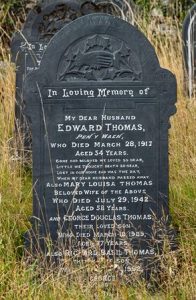
Evan Thomas, Private, 40464, Royal Welsh Fusiliers. Evan was born in 1881, the son of Thomas Peter Thomas and Catherine Thomas (nee Jones), of Cae ‘Ol, Llangelynnin. His mother died when he was young, so Evan was raised with relatives before finding work as a quarryman at Penmaenmawr. He enlisted at Llanfairfechan into the Royal Welsh Fusiliers and was drafted to France in the summer of 1916, joining the 1st Battalion, Royal Welsh Fusiliers, which was attached to 22 Brigade, 7th Division. The Division had suffered heavy casualties during the opening days of the Somme offensive, which had opened on 1 July 1916, and Evan would have been among a large number of drafts for the 1st RWF. The battalion then took part in further attacks to push forwards, to the south of Mametz Wood, and upon being relieved, witnessed the troops of the 38th (Welsh) Division moving forward to launch its assault on Mametz Wood. On 14 July, with the wood taken, the 7th Division moved back into the line, with orders to capture Bazentin-le-Petit, before taking part in the terrible attacks on High Wood over the coming days. On 22 July the 1st RWF was relieved, moving back into reserve to rest and rebuild at La Chaussee. By 12 August the battalion had moved forwards to Dernancourt, and on 26 August marched further forward, to take part in the Divisions assault on Ginchy. The Division saw heavy fighting over the coming days, before the 1st RWF had another short break, but on 1 September the battalion received orders to push forwards again to launch a fresh assault on Ginchy from Montauban Alley. On 3 September 1916 the 1st RWF launched its assault, but suffered severe casualties, with over 200 officers and men killed, wounded or missing. The Division then took part in the Battle of Delville Wood, and the Battle of Guillemont, before spending the winter on the Ancre. In March 1917 the division followed up the German Retreat to the Hindenburg Line, after discovering that the village of Bucquoy had been evacuated, and began slowly following up the withdrawal, passing through St. Leger and Croisilles. Evan was wounded while the battalion was scouting around Croisilles on 29 March and was evacuated to the Casualty Clearing Station at Colincamps, where he died of his wounds on 5 April 1917. The 25-year-old was buried in Euston Road Cemetery, Colincamps, France.
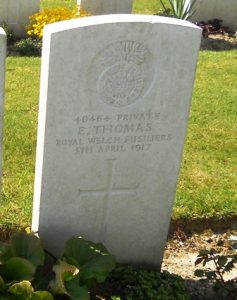
John Elias Williams, Private, 28453, South Wales Borderers. John was born in 1896, the son of John William Williams and Ellen Williams (nee Hughes), of Pontgwan, Caerhun. By 1911 the family had moved to Manchester House, Roewen, Tal-y-Cafn. John had enlisted at Colwyn Bay into the 4th Battalion, Royal Welsh Fusiliers, but upon being drafted to Egypt early in 1916 was posted to the 4th Battalion, South Wales Borderers, which was attached to the 40th Brigade, 13th (Western) Division. The division had seen service at Gallipoli before being evacuated from Helles, and by 31 January was concentrated at Port Said, where they held forward posts in the Suez Canal defences. On 12 February 1916 the Division began to move to Mesopotamia, to strengthen the force being assembled for the relief of the besieged garrison at Kut al Amara, but the relief failed, and Kut fell to the Turks. The Division then took part in the advance through Mesopotamia, which was to successfully liberate the country from centuries of Ottoman rule. John was killed in action in Mesopotamia on 29 March 1917, just weeks after the fall of Baghdad. The 21-year-old has no known grave and is commemorated on the Basra Memorial, Iraq.
World War Two, 1939-1945
Robert William Davies, Private, 14640103, Royal Warwickshire Regiment. Robert was born in 1925, the son of Cromwell Davies and Dora Davies (nee Williams), of Bod Gwynedd, Talybont. He enlisted into the army and was posted to the 1/7th Battalion, Royal Warwickshire Regiment. The battalion was a Territorial Army unit which had been in France with the BEF in 1940, attached to the 143rd Infantry Brigade, 48th (South Midland) Infantry Division. The division saw heavy fighting along the Ypres–Comines Canal whilst holding the sector south of Houthem, Belgium between 26 May 1940 and 28 May 1940, helping allow the rest of the BEF to retreat towards Dunkirk. After its evacuation from Dunkirk, the battalion rebuilt before transferring to the 197th Infantry Brigade, 59th (Staffordshire) Infantry Division, which was in Northern Ireland. The battalion landed at Gold Beach in Normandy with the division at the end of June 1944 and joined the fight to break out from the Normandy beachhead. The division saw its first major action during Operation Charnwood, an attempt to secure the city of Caen. The city was bombed mercilessly on the night of 7 July and on the following morning the 59th Division, supported by the 27th Armoured Brigade, with the British 3rd Division on the left and the 3rd Canadian Division on the right, launched their attack. The division suffered heavy casualties over the coming days, fighting against fanatical SS and Hitlerjugend units, before being relieved on 10 July, after clearing up the final German pockets of resistance in the city. The division then received its orders to take part in the next attack, Operation Goodwood, so on 14 July moved forward ready to attack. The attack began during the morning of 16 July but met heavy resistance from the stubborn German defenders. Robert was killed on 17 July 1944, during fighting for the Ferme de Guiberon. The 19-year-old is buried in Fontenay-Le-Pesnel War Cemetery, Tessel, France.
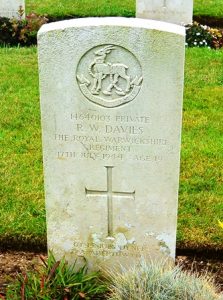
Rees Harold Jones, Flying Officer, 171937, Royal Air Force Volunteer Reserve. Rees was born in 1922, the son of William Gethin Jones and Catherine Agnes Jones (nee Evans), of Wentworth, Dolgarreg. He enlisted into the Royal Air Force Volunteer Reserve and after being commissioned as a Flying Officer in January 1944 was posted to No 7, Flying Instructor’s School at RAF Upavon, in Wiltshire. Rees began struggling with his health during his time at Upavon, and died of tuberculosis at the RAF Hospital, at Wroughton on 23 June 1945. The body of the 23-year-old was conveyed home and he was buried in St. Mary’s Churchyard, Caerhun. Rees is not commemorated on the Caerhun war memorial.
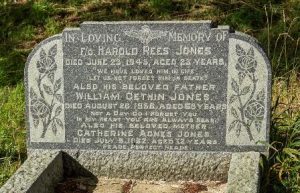
Edward Roberts, Aircraftman 1st Class, 992944, Royal Air Force Volunteer Reserve. Edward was born on 22 March 1921, the son of Hugh Roberts and Mary Elizabeth Roberts (nee Taylor), of Cefn Issa, Tynygroes. He enlisted into the Royal Air Force Volunteer Reserve and was posted to RAF Leeming, in Yorkshire. The station was a Bomber Command base and became used by several squadrons, mostly using the Handley Page Halifax heavy bombers. Edward became ill during the spring of 1941 and died of pneumonia on 9 March 1941. The body of the 21-year-old was conveyed home and he was buried in St. Mary’s Churchyard, Caerhun.
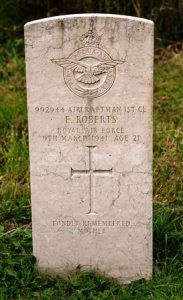
Albert Williams, Sergeant, 1101199, Royal Air Force Volunteer Reserve. Albert was born in 1920, the son of Robert Thomas Williams and Mary Williams (nee Owen), of Rhun Works, Tynygroes. He enlisted into the Royal Air Force Volunteer Reserve and after training as a Navigator/ Bomber was posted to the 5th Middle East Training School at RAF Shallufa, in Egypt, to complete his training. On 10 May 1943, Albert took off from Shallufa aboard a Martin B-26 Marauder Ia, Serial FK376, on a fighter affiliation exercise. The aircraft was flying some two miles southwest of Abu Sueir when the tail of the Marauder broke away and the aircraft crashed, killing all her crew of seven men. Albert was 22 years old when he was killed that day. He is buried besides his fellow crewmen in Moascar War Cemetery, Egypt.
